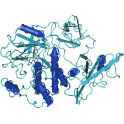
- Remove this product from my favorite's list.
- Add this product to my list of favorites.
Products
Newsletter
 |  |  |  |  |  |

Background: Src-family tyrosine kinases (SFK) are nonreceptor tyrosine kinases playing a critical role in mediating many cellular pathways such as proliferation, adhesion, survival, differentiation and cell motility. The structure of Src kinases is highly conserved consisting of an N-terminal membrane localization motif, a unique region, a Src homology 3 (SH3) domain, a Src homology 2 (SH2) domain, a kinase domain, and a C-terminal, regulatory tail. A phosphorylated tyrosine (Tyr 527) is bound by the SH2 domain through an intra-molecular interaction packing together with the SH3 domain the back of the kinase domain and preventing full activity of Src. Protein–tyrosine phosphatases such as PTPα displace phosphotyrosine 527 from the Src SH2 domain and mediate its dephosphorylation resulting to Src kinase activation. Loss of the negative-regulatory C-terminal segment, as occurs in v-Src, has been shown to result in increased activity and transforming potential. Activation of SRC is also achieved by direct binding of focal adhesion kinase (FAK) and CRK-associated substrate (CAS) to the SH2 domain or by interaction with numerous receptor tyrosine kinases (RTKs), such as epidermal growth factor receptor (EGFR), HER2, fibroblast growth factor receptor (FGFR), platelet-derived growth factor receptor (PDGFR), and vascular endothelial growth factor receptor (VEGFR).
Recombinant human protein kinase SRC, amino acids M1-L536, N-terminally fused to GST-HIS6-Thrombin cleavage site
Theoretical MW : 89.74 kDa (fusion proteins)
Expression system: Baculovirus infected Sf9 cells
Storage buffer: 50 mM HEPES pH 7.5, 100 mM NaCl, 5 mM DTT, 4 mM reduced glutathione, 20% glycerol
Storage temperature: - 80°C (avoid repeated freeze-thaw cycles !)
Protein concentration: 0.239 mg/ml (Bradford method using BSA as standard protein)
Method for determination of Km value & specific activity: Filter binding assay MSFC membrane
Specific activity: 254,000 pmol/mg x min
Entrez Gene ID: 6714
UniProtKB: P12931
Ordering information: shipped on dry ice
Bradshaw JM.(2010) “The Src, Syk, and Tec family kinases: distinct types of molecular switches.”
Cell Signal., 22(8):1175-84.
Roskoski R Jr.(2004) “ Src protein-tyrosine kinase structure and regulation.” Biochem Biophys Res Commun. 26;324(4):1155-64.
Xu W., Harrison S.C., Eck M.J. (1997),”Three-dimensional structure of the tyrosine kinase c-Src.” Nature Vol 385: 595-601
Thomas S.M., Brugge J.S. (1997),”Cellular functions regulated by Src family kinases”, Annu. Rev. Cell Dev. Biol. 13:513- 609
Fischer JJ, Dalhoff C, Schrey AK, Graebner OY, Michaelis S, Andrich K, Glinski M, Kroll F, Sefkow M, Dreger M, Koester H. (2011) "Dasatinib, imatinib and staurosporine capture compounds - Complementary tools for the profiling of kinases by Capture Compound Mass Spectrometry (CCMS)." J Proteomics.75(1):160-8.
Welcome Login
Contact us
Follow us